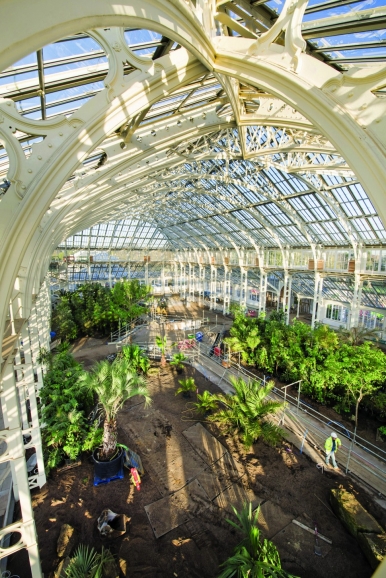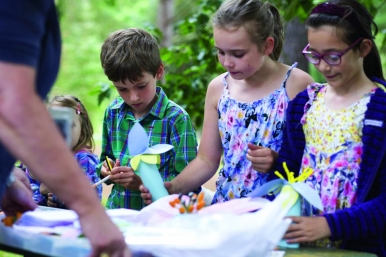Kew’s iconic Temperate House opens after a five-year major restoration.


By the turn of the century, botanists had all but given up hope of finding any remaining Dombeya mauritiana trees in the wild, as the last specimen had been found in Mauritius in 1976. Sightings — and news of sightings — of this beautiful tree with its pendant pink flowers in its native habitat had dwindled, and the tree was considered extinct.
So, when news filtered down of a possible sighting in the midst of a virtually impenetrable guava thicket in the centre of the island, Royal Botanic Gardens, Kew horticulturalists collaborated with a local team and fought their way through the jungle to find it. Imagine their surprise when instead of a small shrub, they found a 10-metre-tall tree! Kew’s plant guru Carlos Magdalena took some cuttings and successfully propagated them — and now visitors from all over the world can view this extremely rare treasure in the newly reopened Temperate House at Kew.

This is just one of many success stories at the Gardens, where horticulturalists regularly ‘save’ species from extinction, often resorting to highly technical propagation methods, including cloning. Once they are saved, they are nurtured in the same sort of environment from whence they came.
Visitors can now view such plants, trace their provenance and follow their histories in the recently restored Victorian glasshouse backing onto the world-famous arboretum in Kew Gardens. Called the Temperate House, it was the world’s largest glasshouse when it was originally built in 1863 adjacent to the Thames; it is now reopening in May 2018 after a five-year restoration project that cost GBP41 million (RM225 million).

Housing 10,000 plants, some of which are extremely rare and threatened, it is simultaneously a temple of plant learning and a showcase of some of our planet’s spellbinding biodiversity. Stories of plant survival from temperate regions around the world — from the Mediterranean, Africa, Australia, New Zealand, South and Central America, Asia and island floras — are both inspirational and educational.
And, naturally, the environment itself is amazingly beautiful.

Intrepid Victorian horticulturalists would open their eyes wide in wonder at the inroads both science and engineering have forged at the “new” glasshouse. Around 400 people laboured for five years to painstakingly renovate 15,000 panes of glass; mend and restore wooden window frames; strip down the structure to its skeleton of wrought and cast iron and steel; then repaint it with four different coats specially designed to protect the metal work from corrosion.
A new heating system utilising a biomass boiler fed with U.K.-sourced wood pellets keeps the temperature above 10 degrees centigrade, and allows for automatic ventilation — a great improvement from the past when all the windows had to be manually opened and closed. It also automatically turns on radiators when the temperatures drop.

New pavers in pale cream lead visitors along pathways that are surrounded by abundant vegetation and a number of imaginative water features, including a central three-metre-high waterfall, some natural-looking cascades, a couple of gentle streams and a terraced water feature built up in natural stone. There’s even a boggy area created at the edges of a pool to display African water-loving plants.
But even though the shell is wondrous to behold, it is the flora that captivates. Whether you are an amateur botanist, a scientist or simply a person who is interested in the natural world, this living, breathing classroom cannot fail to delight. Before the renovation, 500 plants were removed and housed in a temporary nursery, where they were nurtured, progagated and grown in a lengthy and delicate process that involved new science, dedication and time. Now, an incredible 10,000 have gone back into the glasshouse.
Stories of some of these unusual plants that Kew has rescued and the journeys they have taken to their new home are spellbinding. Take the Tree Daisy (Cylindrocline lorencei), for example. Seeds from the last wild plant had been collected, but would not germinate using conventional methods, so Kew’s scientists turned to micropropagation.
First, they identified a small number of living cells contained within the embryos of seeds from one plant. Next, some of these living cells were extracted and cultured.

Slowly but steadily, they multiplied under sterile conditions in the laboratory. After several years of patient work, three clones were successfully reared and may now be viewed in the Temperate House.
In contrast to the sumptuous, romantic surroundings of the Temperate House, these plants also showcase how humankind is allowing them to fall prey to a variety of threats — educating us about their potential and how important it is to prevent them from dying out. After all, they may hold the secrets for survival or may be the custodians of potential cures for cancer, ebola or other life-threatening diseases.

Richard Barley, the Director of Horticulture at the Royal Botanic Gardens, Kew notes that the Garden’s experts have over 250 years of plant expertise, worldwide collections, partnerships spanning 110 countries, and 131 hectares that make up the most biodiverse place on the planet.
As such, they are well-placed to bring global attention to plants threatened by extinction. It isn’t any surprise that the Gardens, originally created in 1759, obtained World Heritage Site status in 2003. After all, they have made significant contributions to the study of plant diversity and economic botany. Sobering at times, exhilarating at others, a visit to the Temperate House is ultimately a life-affirming experience.

In addition to general entrance, there are also learning experiences and artistic performances to enjoy. Cirque Bijou, a troupe of acrobats and musicians, has a schedule of regular performances featuring aerialists and live music.
Inspired by the Temperate House and the rare plants within, it pushes the boundaries of the contemporary circus act. There is also an interactive walking tour specially designed for families: ‘Gnomus’, a larger-than-life puppet, leads groups around the Temperate House, highlighting the building’s most interesting stories to elicit interest around the vital importance of plants. It’s a great way for children to learn about some of the challenges facing our planet.
Easily accessed from central London, a visit to Kew’s Temperate House not only provides for a fun day out, it’s also a learning experience, giving all of us food for thought about the fragility — and biodiversity — of our planet.









